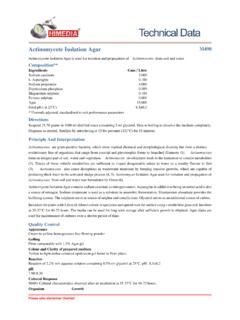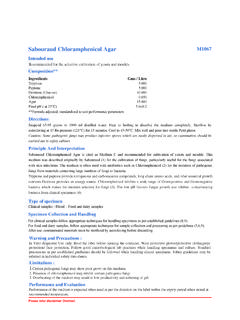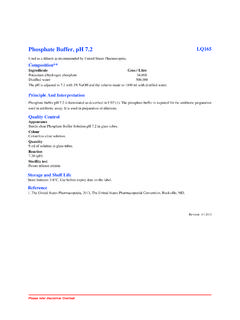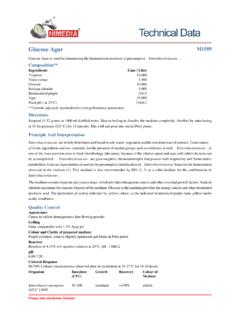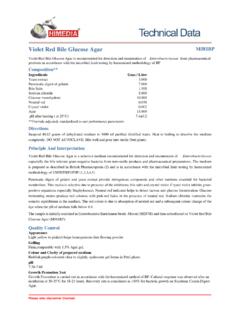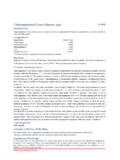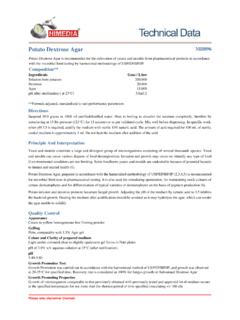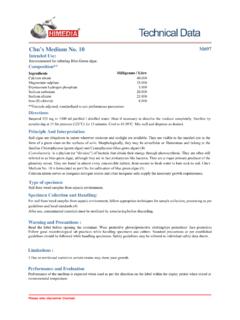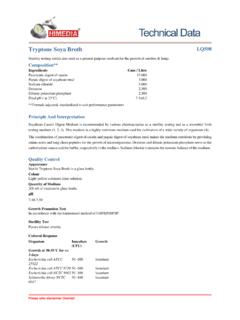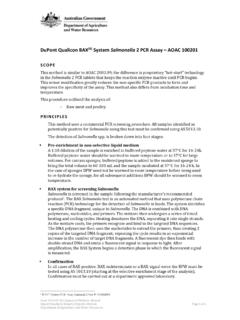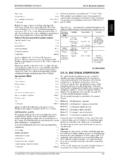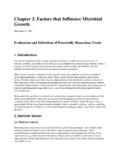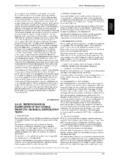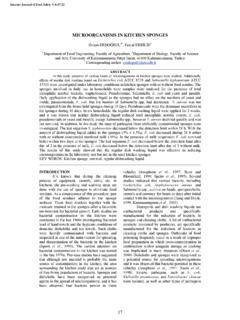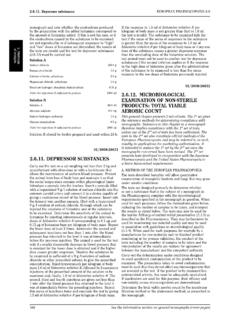Transcription of Buffered Sodium Chloride-Peptone Solution pH 7
1 Buffered Sodium Chloride-Peptone Solution pH useMH1275 Recommended as a diluent for carrying out microbial limit testing by harmonized methodology of pharmaceutical products in accordance with USP/EP/BP/ **IngredientsGms / LitrePotassium dihydrogen hydrogen phosphate peptone # pH ( at 25 C) tube or flaskDirectionsSuspend grams (the equivalent weight of dehydrated medium per litre) in 1000 ml purified /distilled water. Heat if necessary to dissolve the medium completely. For preparation of nonfatty products insoluble in water, add % w/v Polysorbate 80 to assist the suspension of poorly wettable substances.
2 Dispense in tubes or flasks or as desired and sterilize by autoclaving at 15 lbs pressure 121 C for 15 minutes or as per validated And InterpretationThe composition of this medium is in accordance with the harmonized methodology of USP/EP/BP/JP/IP (1,2,3,4,5). This medium is recommended for preparation of stable test strain suspension employed for validating the microbiological testing procedures of non-sterile products. The standardized stable suspensions are used so that the suitability of this test to detect microorganism in presence of product can be established.
3 Non-fatty products insoluble in water and water-soluble products are diluted/dissolved using this peptone serves as nutrient source and maintains the cell viability. Phosphates in the medium act as good buffering agents. Sodium chloride maintains the osmotic balance and cell integrity. Polysorbates reduce surface tension and also inactivate phenolic compound, if present in the test of test strain is recommended in Buffered Sodium Chloride-Peptone Solution pH (MH1275) at 30-35 C wherein there is no multiplication of organisms or there is no decrease in count for upto 4 hours.
4 **Formula adjusted, standardized to suit performance parameters # peptone (meat or casein)Type of specimen Pharmaceutical samples For pharmaceutical samples follow appropriate techniques for handling specimens as per established guidelines (1,2,3,4,5). After use, contaminated materials must be sterilized by autoclaving before discarding. Specimen Collection and Handling: Warning and Precautions Read the label before opening the container. Wear protective gloves/protective clothing/eye protection/ face protection. Follow good microbiological lab practices while handling specimens and culture.
5 Standard precautions as per established guidelines should be followed while handling specimens. Safety guidelines may be referred in individual safety data sheetsLimitations :This medium contains less nutrients and is not recommended for the growth of microrganismsHiMedia LaboratoriesTechnical DataPlease refer disclaimer of test strainEscherichia coli ATCC 8739 (00012*) 50 -100no decrease incolony countno decrease incolony countno decrease incolony count(stored at2-8 C)Escherichia coli ATCC25922 (00013*)50 -100no decrease incolony countno decrease incolony countno decrease incolony count(stored at2-8 C)
6 Escherichia coli NCTC 900250 -100no decrease incolony countno decrease incolony countno decrease incolony count(stored at2-8 C)Staphylococcus aureus subsp. aureus ATCC 6538 (00032*)50 -100no decrease incolony countno decrease incolony countno decrease incolony count(stored at2-8 C)Staphylococcus aureus subsp. aureus ATCC 25923 (00034*)50 -100no decrease incolony countno decrease incolony countno decrease incolony count(stored at2-8 C)Pseudomonas aeruginosa ATCC 9027 (00026*)50 -100no decrease incolony countno decrease incolony countno decrease incolony count(stored at2-8 C)Pseudomonas aeruginosa ATCC 27853 (00025*)50 -100no decrease incolony countno decrease incolony countno decrease incolony count(stored at2-8 C)Salmonella Typhimurium ATCC 14028 (00031*)50 -100no decrease incolony countno decrease incolony countno decrease incolony count(stored at2-8 C)
7 Growth Promotion TestGrowth Promotion is carried out in accordance with the harmonized method of ICH(USP/EP/BP/JP/IP).Cultural responseCultural characteristics observed after recovery on Soybean Casein Digest Agar after an incubation at 30-35 C for 18-24hours for bacteria and Sabouraud Dextrose Agar at 30-35 C for 24-48 hours .Cultural Response OrganismInoculum(CFU)Recoverywithin 2 hoursof incubationRecoverywithin 4 hoursof incubationRecoverywithin 24 hours of ControlAppearanceWhite to cream homogeneous free flowing powderColour and Clarity of prepared medium Colourless to pale yellow clear Solution w/o any precipitatepHPerformance and EvaluationPerformance of the medium is expected when used as per the direction on the label within the expiry period when stored at recommended Abony NCTC6017 (00029*)
8 50 -100no decrease incolony countno decrease incolony countno decrease incolony count(stored at2-8 C)Bacillus subtilis subsp. spizizenniiATCC 6633 (00003*)50 -100no decrease incolony countno decrease incolony countno decrease incolony count(stored atHiMedia LaboratoriesTechnical Pharmacopoeia, 2017 The Stationery office British Pharmacopoeia, 2016, European Dept. for the quality of Pharmacopoeia, Pharmacopoeia, 2018, Govt. of India, the controller of Publication, Delhi, : 04 / United States Pharmacopoeia, 2018, The United States Pharmacopoeial Convention.)
9 Rockville, C)Micrococcus luteus ATCC934150 -100no decrease incolony countno decrease incolony countno decrease incolony count(stored at2-8 C)Candida albicans ATCC1023150 -100no decrease incolony countno decrease incolony countno decrease incolony count(stored at2-8 C)Candida albicans ATCC209150 -100no decrease incolony countno decrease incolony countno decrease incolony count(stored at2-8 C)Storage and Shelf LifeStore between 10-30 C in a tightly closed container and the prepared medium at 2-8 C. Use before expiry date on the label. On opening, product should be properly stored dry, after tightly capping the bottle inorder to prevent lump formation due to the hygroscopic nature of the product.
10 Improper storage of the product may lead to lump formation. Store in dry ventilated area protected from extremes of temperature and sources of ignition Seal the container tightly after use. Use before expiry date on the performance is best if used within stated expiry period. User must ensure safe disposal by autoclaving and/or incineration of used or unusable preparations of this product. Follow established laboratory procedures in disposing of infectious materials must be decontaminated and disposed of in accordance with current laboratory techniques (6,7).

